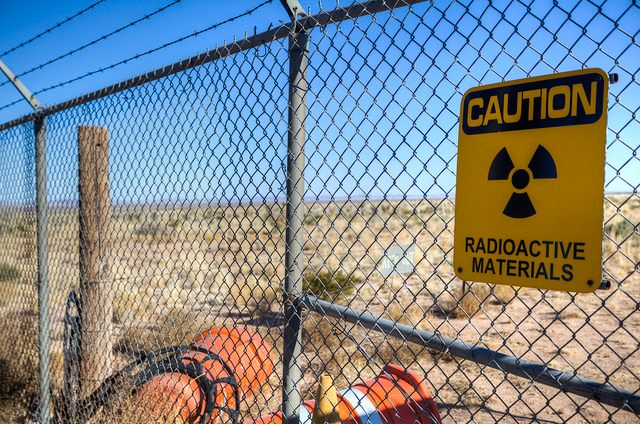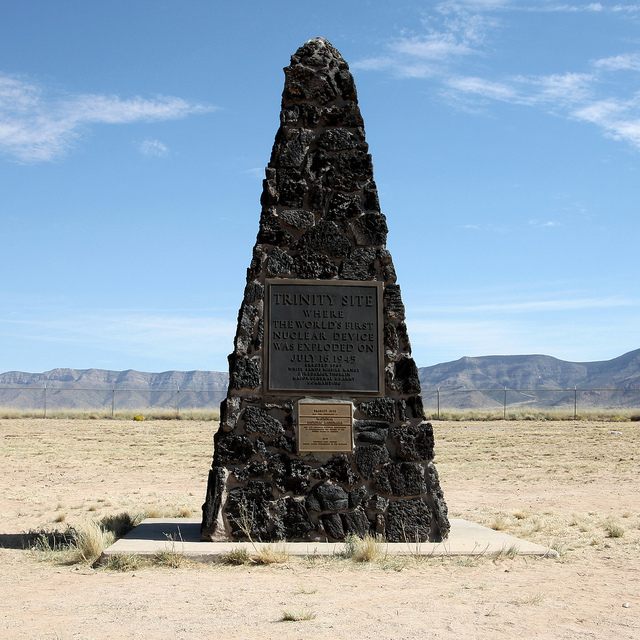These Atomic Tourists Have Visited 160 Forgotten Nuclear Sites Across the U.S.
 The Trinity test site today. (Photo: Terry Robinson/flickr)
The Trinity test site today. (Photo: Terry Robinson/flickr)
Twice a year, for six hours only, the Trinity Test Site is open to the public. It’s your only chance for a self-guided visit to the New Mexico site where the first atomic bomb was detonated. There’s no tours or ceremonies, and no admission fee. Children and pregnant women are welcome, but whether or not it’s a good idea is up in the air–the US Army’s website about the open house stresses “the choice is yours.”
An hour’s visit to the site, which temporarily opened its Stallion Gate entrance this past weekend, only exposes visitors to one-half to one millirem of radiation. That’s less than the exposure you’d receive from a coast-to-coast plane trip. The average person receives about 360 millirems annually from producers like food, buildings, and the sun, whether or not they travel via plane or visit historical nuclear testing sites.
There’s not much to see at Trinity other than a single stone obelisk, a slight crater, the ranch house “the gadget” was built in, and the mountains in the distance. For many, though, that’s enough. For other atomic tourists, this occasionally-accessible test site is only the beginning.
 The first detonation of a nuclear weapon, conducted by the United States Army on July 16, 1945, code-named ‘Trinity’. (Photo: Public Domain/WikiCommons)
The first detonation of a nuclear weapon, conducted by the United States Army on July 16, 1945, code-named ‘Trinity’. (Photo: Public Domain/WikiCommons)
Timothy Karpin and James Maroncelli, authors of The Traveler’s Guide to Nuclear Weapons and founders of AtomicTraveler.com, have visited some 160 sites across the nation that had some role in atomic history. Los Alamos, Hanford, and Oak Ridge National Lab in Tennessee are the most well-known Manhattan Project weapons development sites. They’re the trio that will eventually become the Manhattan Project National Park. But, as Maroncelli and Karpin discovered after some historical sleuthing, they’re far from the only nuclear weapons development sites.
Most of the other sites, the smaller ones that produced metal sheeting or did ballistics tests or housed uranium mills, lack so much as a sign to announce their historical significance. “The obscurity didn’t really become illuminated until we started pulling up this huge lists of facilities, and once we started trying to find these places then it got interesting,” says Karpin, who spent six years traveling the country in search of the sites.
 Base camp at the Trinity test site. (Photo: Public Domain/WIkiCommons)
Base camp at the Trinity test site. (Photo: Public Domain/WIkiCommons)
Tracking down nuclear sites wasn’t easy. To start with, they had to pore through biographies, letters, town and county records and government lists to find places that were involved in weapons assembly. Once they arrived at a location, they weren’t always welcome.
“We did run into a variety of security guards and people who did not smile, who were resistant of giving us information,” says Maroncelli. “Once things are classified, nobody ever finds out if they’re unclassified.”
Multiple times, the atomic travelers had to rely on their confidence in their research to find historic locations. Many have become everyday locations, such a uranium shaping plant in Chicago named Quality Hardware. The original building still stands, but it’s since become a cluster of townhomes inhabited by people with no idea of the site’s history.
 Trinity Site Obelisk National Historic Landmark. (Photo: Samat Jain/flickr)
Trinity Site Obelisk National Historic Landmark. (Photo: Samat Jain/flickr)
The idea for a book dedicated to overlooked atomic history locations was born over drinks; each author had independently brushed up against remnants of the U.S.’s nuclear history, and realized it was so much more expansive than most people knew about.
Maroncelli’s first taste of atomic tourism came when he found himself at Los Alamos National Laboratory while helping a friend move to Albuquerque. Standing at the corner of Ashley Pond, gazing out towards the Los Alamos Ranch School that served as a social space for the Manhattan Project scientists, he was overcome by just how important the site was.
But the first time Karpin got a taste of nuclear history, he was underwhelmed. It was at Brookhaven National Lab on Long Island, which he visited as a child growing up in the area. “I remember standing in front of this massive pile and they were trying to convince me I should be terribly fascinated,” he says.
 Nuclear reactors line the riverbank at the Hanford Site along the Columbia River, January 1960. The N Reactor is in the foreground, with the twin KE and KW Reactors in the immediate background. The historic B Reactor, the world’s first plutonium production reactor, is visible in the distance. (Photo: Public Domain/WikiCommons)
Nuclear reactors line the riverbank at the Hanford Site along the Columbia River, January 1960. The N Reactor is in the foreground, with the twin KE and KW Reactors in the immediate background. The historic B Reactor, the world’s first plutonium production reactor, is visible in the distance. (Photo: Public Domain/WikiCommons)
Years later, however, Karpin trekked from New York to Washington with his wife. At the end of the trip, he convinced her to go to Washington’s Hanford facility with him, infamous for being one of the most radioactive sites in the United States. “That’s when I first really had my first taste of a facility that was involved in weapons production.”
Many of their finds came from sheer stubbornness. They discovered a forgotten nuclear casings testing facility by heading off into the woods, despite insistence from public relations officers at a nearby military base that nothing was out there. First, they found a ring that belonged to a swivel position for a cannon. Going even further, they emerged into a clearing full of giant blocks of concrete, between 12 and 15 feet tall, where the casings were fired to test their strength.
Karpin says, “You can almost see them on Google Earth, and they had no idea that they had these on their own naval bases.”
 Warning sign at entry to Hanford Site, Washington. (Photo: Tobin Fricke/WikiCommons CC BY-SA 3.0)
Warning sign at entry to Hanford Site, Washington. (Photo: Tobin Fricke/WikiCommons CC BY-SA 3.0)
Despite the difficulty in tracking down specific sites, nuclear weapons development was so extensive that “anyone who takes a clear flight over the United States will be flying over some of these facilities,” says Maroncelli. “There were thousands of different companies and organizations working on nuclear weapons production.”
Based on the sites they’ve found, the atomic travelers estimate a huge fraction of the population had a hand in creating nuclear weapons, whether they knew it or not.
 A billboard encouraging secrecy among Oak Ridge workers. (Photo: Public Domain/WikiCommons)
A billboard encouraging secrecy among Oak Ridge workers. (Photo: Public Domain/WikiCommons)







Follow us on Twitter to get the latest on the world's hidden wonders.
Like us on Facebook to get the latest on the world's hidden wonders.
Follow us on Twitter Like us on Facebook